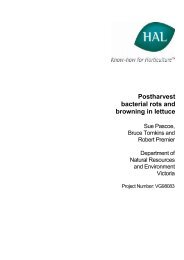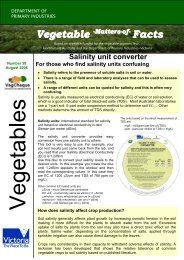Silverleaf Whitefly Management
Silverleaf Whitefly Management
Silverleaf Whitefly Management
- No tags were found...
You also want an ePaper? Increase the reach of your titles
YUMPU automatically turns print PDFs into web optimized ePapers that Google loves.
VEGEnotes<strong>Silverleaf</strong> <strong>Whitefly</strong>Table 2. Action thresholds for <strong>Silverleaf</strong> Whitefl y nymphs.CropsThreshold based on totalnymph countsThreshold based onlarge nymphsTomato (indeterminate gourmet) 5–8 nymphs/leaflet 2–3 nymphs/leafletTomato (determinate round) 8–10 nymphs/leaflet 3–4 nymphs/leafletZucchini (young crop) 3–4 nymphs/leaf 1 nymph/leafZucchini (mature crop) 6–8 nymphs/leaf 2–3 nymphs/leafSynthetic pyrethroid insecticides applied as foliarsprays are used to control for SLW in vegetables.However, they are contact insecticides so smalldroplet sizes, high volumes and good croppenetration are necessary for good coverageof the underside of leaves, especially in oldercrops. Organophosphate insecticides give poorcontrol and can lead to rapid increases in SLWnumbers, probably due to suppression of naturalenemies. However, tank mixtures of pyrethroidand organophosphate insecticides can be usefulin some situations.The neo-nicotinoid insecticide ‘Confidor’ can beused to control whitefly in some vegetable crops.It has systemic action, if applied around the rootzone of the crops, and is mainly effective againstfeeding adults and nymphs. It has a short life insunlight, so should be used quickly after mixing.Don’t use it more frequently than every 3–4weeks and be aware that resistance seems to bedeveloping.Resistance managementThe keys to resistance management are:• Identify your pests before spraying. Do notassume SLW until it has been positivelyidentified.• Minimise chemical use. Spray only infestedareas and only as needed. Routine ‘calendar’sprays applied as a precaution againstinfestation are a recipe for disaster.• Use sticky cards and scouting to locate thepopulation before it spreads.• Spray an infestation thoroughly, then stop andmonitor to assess the impact.• If possible, rotate to a new chemical groupevery month to preserve the effectiveness ofeach chemical used.• Apply chemicals only at the recommendedrate.• Maximise spray coverage. Calibratesprayers, use the finest droplet sizepossible and make sure the under-surfaceof all leaves in the target crop is thoroughlycovered. Hand pump knapsack typesprayers are totally inadequate. Poor spraycoverage will necessitate repeat sprayingand speed the development of resistance.Biological controlIn late 2004, CSIRO Entomology was grantedpermission by the Australian Government torelease a very tiny, stingless parasitic wasp.Eretmocerus hayati, originally from Pakistan,is being used successfully against SLW inthe Lower Rio Grande in south Texas (USA).With a similar climate to coastal and centralhighland areas of Queensland, this area wasan ideal source for the wasp. Stringent testingin quarantine in Brisbane showed it wouldattack only SLW once released in Australia.Further readingThe Nursery PapersIssue no 1997/009, ISSN:1326-1495www2.dpi.qld.gov.au/horticultureresearch/18362.htmlAcknowledgementCompiled from information supplied by SivaSubramaniam, QLD DPIF and Paul De Barro,CSIRO Entomology, QLD.DISCLAIMER: Every attempt is made to ensure theaccuracy of all statements and claims made in Vegenotes.However, due to the nature of the industry, it is impossiblefor us to know your precise circumstances. Therefore, wedisclaim any responsibility for any action you take as a resultof reading Vegenotes.ISSN: 1449 - 1397Copyright©: Horticulture Australia 2006No part of this publication can be copied or reproduced withoutthe permission of the original authors.VEGEnotes is coordinated, edited & printed by:ARRIS Pty Ltd, ph 08 8303 7247 fax 08 8303 6752Level 1, 50 Carrington StreetSydney NSW 2000 AustraliaTelephone (02) 8295 2300Facsimile (02) 8295 2399www.horticulture.com.auYour levy @ work
















